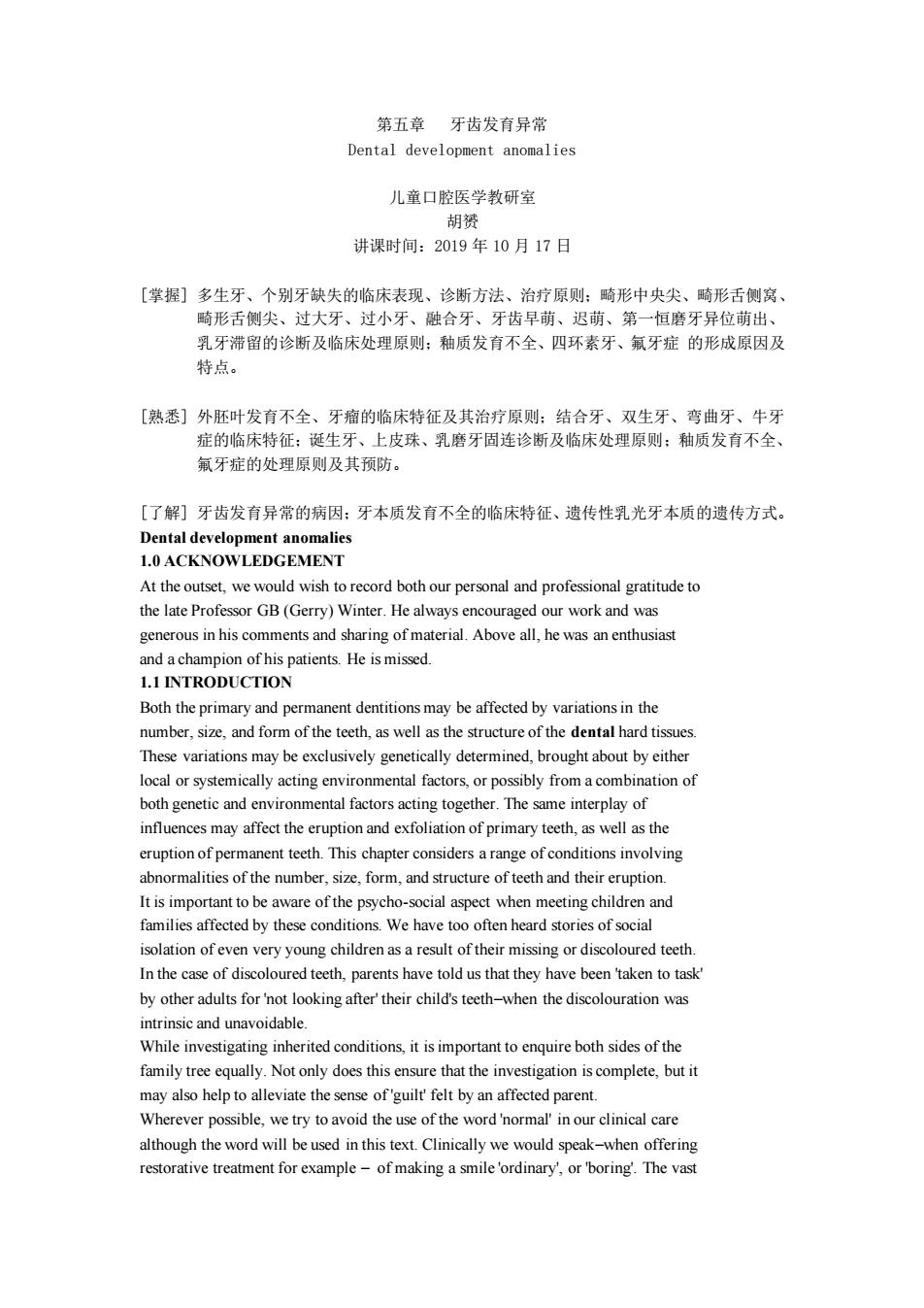
第五章牙齿发有异常 Dental development anomalies 儿童口腔医学教研室 胡 讲课时间:2019年10月17日 [掌握]多生牙、个别牙缺失的临床表现、诊断方法、治疗原则:畸形中央尖、畸形活侧窝、 畸形活侧尖、过大牙、过小牙、融合牙、牙齿早萌、迟萌、第一恒磨牙异位萌出、 到牙带留的诊断及临床处理原则:釉质发育不全、四环素牙、氟牙定的形成原因及 特点。 [熟悉]外胚叶发有不全、牙瘤的临床特征及其治疗原则:结合牙、双生牙、弯曲牙、牛牙 [了解]牙齿发有异常的病因:牙本质发有不全的临床特征、遗传性乳光牙本质的遗传方式。 At the outset,we would wish to record both our personal and professional gratitude to the late Professor GB(Gerry)Winter.He always encouraged our work and was all,he was anenthusiast 1.I INTRODUCTION Both the primary and permanent dentitions may be affected by variations in the umber,size.and form of the teethas well as the structure of the dental hard tisse These variations may be excusively genetically.brought about byh ocal or systemically acting environmental factors,or possibly from a combination of both genetic and environmental factors acting together.The same interplay of nfluences may affect the primary teethas well as the eruption of permanent teeth This chapter considers a range of conditions involving abnormalities of the number.size.form.and structure of teeth and their eruption. It is important to be aware of the psycho-social aspect when meeting children and families affected by these conditions We have to often heard stories of social onof even very young childrenasaresult of their missing or teeth In the case of discoloured teeth,parents have told us that they have been 'taken to task by other adults for not looking after'their child's teeth-when the discolouration was eritd condtio it ismorant tour bohe family tree equally.Not only does this ensure that the investigation is complete.but it may also help to alleviate the sense of 'guilt'felt by an affected parent. Wherever possible,we try to avoid theuse of the word normal'care although the word will be used in this text.Clinically we would speak-when offering restorative treatment for example of making a smile 'ordinary,or 'boring.The vast
第五章 牙齿发育异常 Dental development anomalies 儿童口腔医学教研室 胡赟 讲课时间:2019 年 10 月 17 日 [掌握] 多生牙、个别牙缺失的临床表现、诊断方法、治疗原则;畸形中央尖、畸形舌侧窝、 畸形舌侧尖、过大牙、过小牙、融合牙、牙齿早萌、迟萌、第一恒磨牙异位萌出、 乳牙滞留的诊断及临床处理原则;釉质发育不全、四环素牙、氟牙症 的形成原因及 特点。 [熟悉] 外胚叶发育不全、牙瘤的临床特征及其治疗原则;结合牙、双生牙、弯曲牙、牛牙 症的临床特征;诞生牙、上皮珠、乳磨牙固连诊断及临床处理原则;釉质发育不全、 氟牙症的处理原则及其预防。 [了解] 牙齿发育异常的病因;牙本质发育不全的临床特征、遗传性乳光牙本质的遗传方式。 Dental development anomalies 1.0 ACKNOWLEDGEMENT At the outset, we would wish to record both our personal and professional gratitude to the late Professor GB (Gerry) Winter. He always encouraged our work and was generous in his comments and sharing of material. Above all, he was an enthusiast and a champion of his patients. He is missed. 1.1 INTRODUCTION Both the primary and permanent dentitions may be affected by variations in the number, size, and form of the teeth, as well as the structure of the dental hard tissues. These variations may be exclusively genetically determined, brought about by either local or systemically acting environmental factors, or possibly from a combination of both genetic and environmental factors acting together. The same interplay of influences may affect the eruption and exfoliation of primary teeth, as well as the eruption of permanent teeth. This chapter considers a range of conditions involving abnormalities of the number, size, form, and structure of teeth and their eruption. It is important to be aware of the psycho-social aspect when meeting children and families affected by these conditions. We have too often heard stories of social isolation of even very young children as a result of their missing or discoloured teeth. In the case of discoloured teeth, parents have told us that they have been 'taken to task' by other adults for 'not looking after' their child's teeth⎯when the discolouration was intrinsic and unavoidable. While investigating inherited conditions, it is important to enquire both sides of the family tree equally. Not only does this ensure that the investigation is complete, but it may also help to alleviate the sense of 'guilt' felt by an affected parent. Wherever possible, we try to avoid the use of the word 'normal' in our clinical care although the word will be used in this text. Clinically we would speak⎯when offering restorative treatment for example ⎯ of making a smile 'ordinary', or 'boring'. The vast
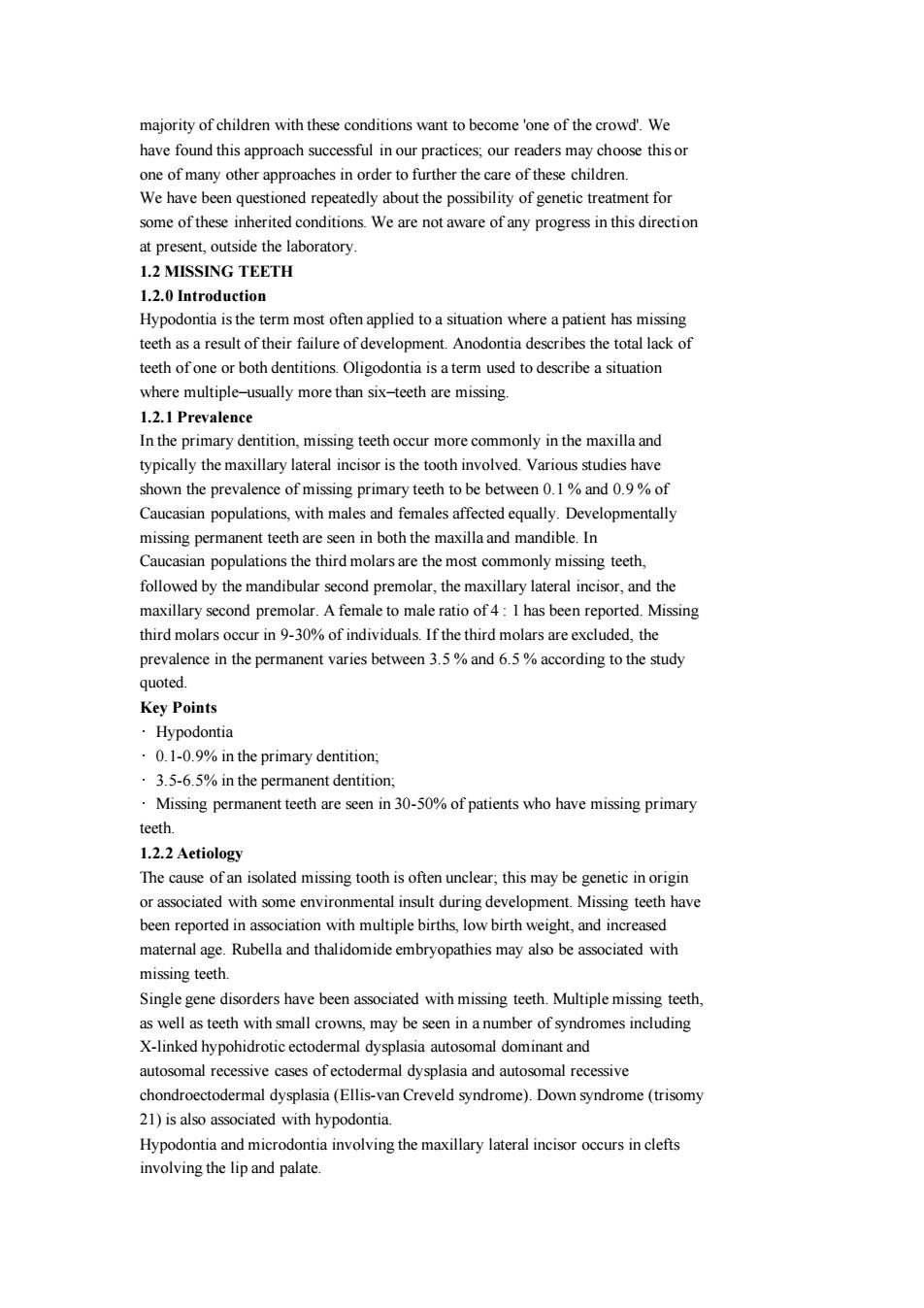
maiority of children with these conditions want to become 'one of the crowd'We ther the care of these children. We have been questioned repeatedly about the possibility of genetic treatment for some of these inherited conditions.We are not aware of any progress in this direction at present,outside the laboratory. 1.2 MISSING TEETH 1.2.0Introductio Hypodontia is the term most often applied toa situation where a patient has missing teeth as a result of their failure of development.Anodontia describes the total lack o teeth ofone or both dentitions.Oligodontia is aterm used to describe a situation where multiple-usually more than six-teeth are missing 1.1 Prevalence nthe primary dentition,missing more commony in the maxilla and typically the maxillary lateral incisor is the tooth involved.Various studies have shown the prevalence of missing primary teeth to be between 0.1 and 0.9%of Caucasian populations,with males and females affected equally.Developmentally nent teeth are seen in both the maxilla and mandible.In populations the the mst followed by the mandibular second premolar,the maxillary lateral incisor,and the maxillary second premolar.A female to male ratio of 4:1 has been reported.Missing third molars occur in90%of individuals If the third molars are excluded,the prevalence in the permanent varies between .%and65%according to the study Hypodontia .0.1-0.9%in the primary dentition; 3.5-6.5%in the permanent dentition Missing perm anent teeth are een n30-0%of patients who have missing primary tecth 1.2.2Aetiology The cause of an isolated missing tooth is often unclear:this may be genetic in origin or associated with some environmental insult during development.Missing teeth have been reported in association with multiple births,low birth weight,and increased matea Rubellaand thalidomide embryopathies may also be iated with missing teeth Single gene disorders have been associated with missing teeth.Multiple missing teeth as well as teeth with small crowns,may be seen in a number of syndromes including X-linked hypohidrotic ectodermal dysplasia autosomal dominant and autosomalr dysplasia and auto omal recessive chondroectodermal ysplasia (Ellis-van Creveld syndrome).Down syndrome (trisomy 21)is also associated with hypodontia. Hypodontia and microdontia involving the maxillary lateral incisor occurs in clefts involving the lip and palate
majority of children with these conditions want to become 'one of the crowd'. We have found this approach successful in our practices; our readers may choose this or one of many other approaches in order to further the care of these children. We have been questioned repeatedly about the possibility of genetic treatment for some of these inherited conditions. We are not aware of any progress in this direction at present, outside the laboratory. 1.2 MISSING TEETH 1.2.0 Introduction Hypodontia is the term most often applied to a situation where a patient has missing teeth as a result of their failure of development. Anodontia describes the total lack of teeth of one or both dentitions. Oligodontia is a term used to describe a situation where multiple⎯usually more than six⎯teeth are missing. 1.2.1 Prevalence In the primary dentition, missing teeth occur more commonly in the maxilla and typically the maxillary lateral incisor is the tooth involved. Various studies have shown the prevalence of missing primary teeth to be between 0.1 % and 0.9 % of Caucasian populations, with males and females affected equally. Developmentally missing permanent teeth are seen in both the maxilla and mandible. In Caucasian populations the third molars are the most commonly missing teeth, followed by the mandibular second premolar, the maxillary lateral incisor, and the maxillary second premolar. A female to male ratio of 4 : 1 has been reported. Missing third molars occur in 9-30% of individuals. If the third molars are excluded, the prevalence in the permanent varies between 3.5 % and 6.5 % according to the study quoted. Key Points • Hypodontia • 0.1-0.9% in the primary dentition; • 3.5-6.5% in the permanent dentition; • Missing permanent teeth are seen in 30-50% of patients who have missing primary teeth. 1.2.2 Aetiology The cause of an isolated missing tooth is often unclear; this may be genetic in origin or associated with some environmental insult during development. Missing teeth have been reported in association with multiple births, low birth weight, and increased maternal age. Rubella and thalidomide embryopathies may also be associated with missing teeth. Single gene disorders have been associated with missing teeth. Multiple missing teeth, as well as teeth with small crowns, may be seen in a number of syndromes including X-linked hypohidrotic ectodermal dysplasia autosomal dominant and autosomal recessive cases of ectodermal dysplasia and autosomal recessive chondroectodermal dysplasia (Ellis-van Creveld syndrome). Down syndrome (trisomy 21) is also associated with hypodontia. Hypodontia and microdontia involving the maxillary lateral incisor occurs in clefts involving the lip and palate
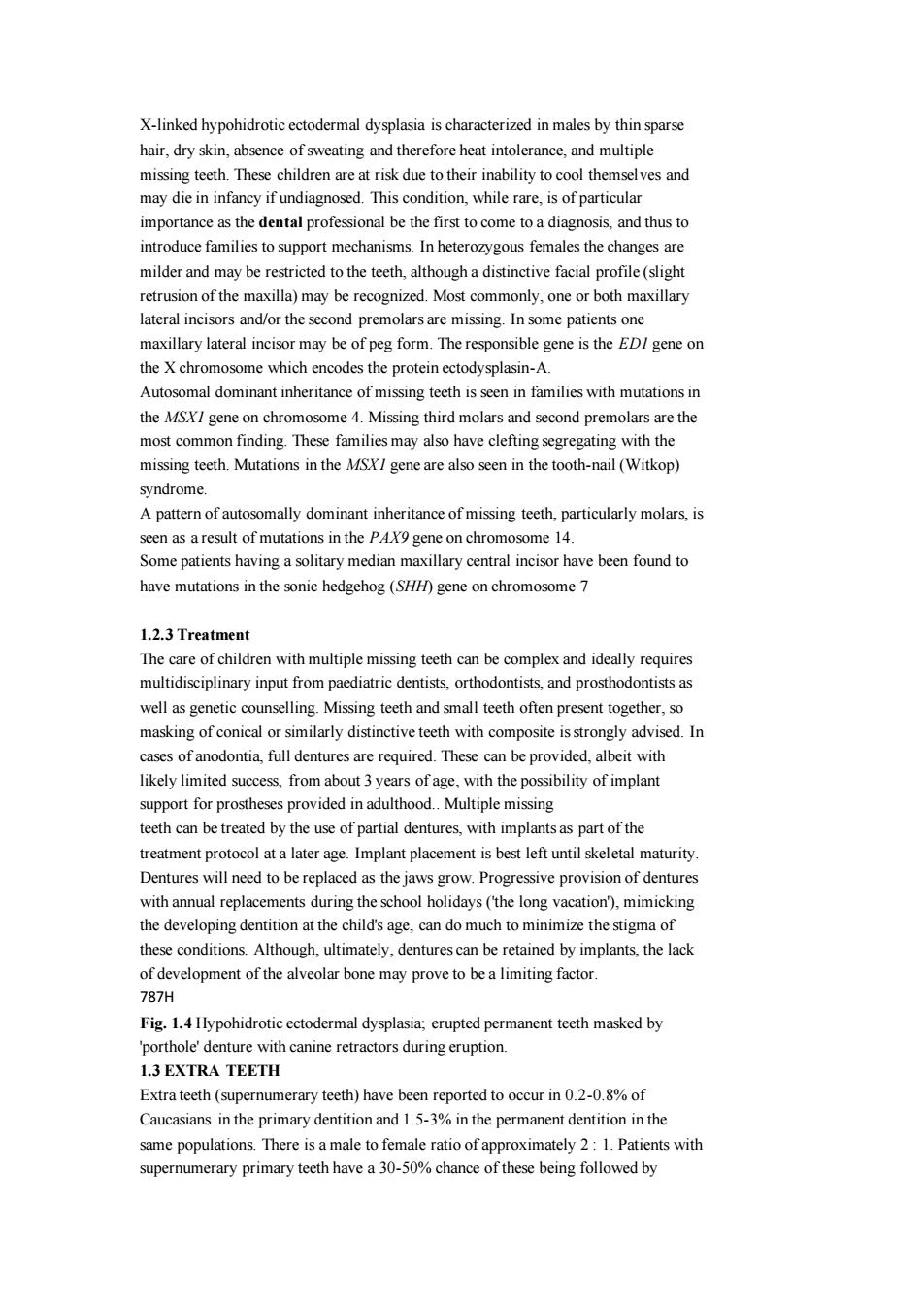
X-linked hypohidrotic ectodermal dysplasia is characterized in males by thin sparse missing teeth.These children are at risk due to their inability to cool themselves and may die in infancy if undiagnosed.This condition,while rare,is of particular importance as the dental professional be the first to come to a diagnosis,and thus to introduce families to support mechanisms.In heterozygous females the changes are stintive facial pro( retrusion of the maxilla)may be recognized.Most commony,one or both maxillary lateral incisors and/or the second premolars are missing.In some patients one maxillary lateral incisor may be of peg form.The responsible gene is the ED/gene on the X chromosome which encodes the protein ectodysplasin-A. Autosomal dominant inheritance of missing teeth is seen in families with mutations in s are the most common finding.These families may also have clefting segregating with th missing teeth.Mutations in the MSY/gene are also seen in the tooth-nail (Witkop) svndrome A pattern of autosmally dominant inheritance of missing teeth,particularly molars is ons in the on chro 14 Some patients havinga median ma illary have been found to have mutations in the sonic hedgehog (SH)gene on chromosome 7 12 3 Treatment g teeth can be comple well as genetic counselling.Missing teeth and small teeth often present together,so masking of conical or similarly distinctive teeth with composite isstrongly advised.In cases of anodontia,full dentures are required.These can be provided,albeit with likely limited suc ss、from about3 s of age,with the sibility of implan port for pros teeth can be treated by the use of partial dentures,with implants as part of the treatment protocol at a later age.Implant placement is best left until skeletal maturity Dentures will need to be replaced as the jaws grow.Progressive provision of dentures with annual replacements during the school holidays(the long vacation)mimicking the developing dentition at the childs age can dom e the stig hese be retair ned by implants,the of development of the alveolar bone may prove to be a limiting factor. 787H Fig.1.4 Hypohidrotic ectodermal dysplasia;erupted permanent teeth masked by 1.3 EXTRA TEETH Extrateeth (supernumerary teeth)have been reported to occurin2-0.% Caucasians in the primary dentition and 1.5-3%inthe permanent dentition in the same populations.There is a male to female ratio of approximately 2:1.Patients with supernumerary primary teeth have a30-50%chance of these being followed by
X-linked hypohidrotic ectodermal dysplasia is characterized in males by thin sparse hair, dry skin, absence of sweating and therefore heat intolerance, and multiple missing teeth. These children are at risk due to their inability to cool themselves and may die in infancy if undiagnosed. This condition, while rare, is of particular importance as the dental professional be the first to come to a diagnosis, and thus to introduce families to support mechanisms. In heterozygous females the changes are milder and may be restricted to the teeth, although a distinctive facial profile (slight retrusion of the maxilla) may be recognized. Most commonly, one or both maxillary lateral incisors and/or the second premolars are missing. In some patients one maxillary lateral incisor may be of peg form. The responsible gene is the ED1 gene on the X chromosome which encodes the protein ectodysplasin-A. Autosomal dominant inheritance of missing teeth is seen in families with mutations in the MSX1 gene on chromosome 4. Missing third molars and second premolars are the most common finding. These families may also have clefting segregating with the missing teeth. Mutations in the MSX1 gene are also seen in the tooth-nail (Witkop) syndrome. A pattern of autosomally dominant inheritance of missing teeth, particularly molars, is seen as a result of mutations in the PAX9 gene on chromosome 14. Some patients having a solitary median maxillary central incisor have been found to have mutations in the sonic hedgehog (SHH) gene on chromosome 7 1.2.3 Treatment The care of children with multiple missing teeth can be complex and ideally requires multidisciplinary input from paediatric dentists, orthodontists, and prosthodontists as well as genetic counselling. Missing teeth and small teeth often present together, so masking of conical or similarly distinctive teeth with composite is strongly advised. In cases of anodontia, full dentures are required. These can be provided, albeit with likely limited success, from about 3 years of age, with the possibility of implant support for prostheses provided in adulthood. Multiple missing teeth can be treated by the use of partial dentures, with implants as part of the treatment protocol at a later age. Implant placement is best left until skeletal maturity. Dentures will need to be replaced as the jaws grow. Progressive provision of dentures with annual replacements during the school holidays ('the long vacation'), mimicking the developing dentition at the child's age, can do much to minimize the stigma of these conditions. Although, ultimately, dentures can be retained by implants, the lack of development of the alveolar bone may prove to be a limiting factor. 787H Fig. 1.4 Hypohidrotic ectodermal dysplasia; erupted permanent teeth masked by 'porthole' denture with canine retractors during eruption. 1.3 EXTRA TEETH Extra teeth (supernumerary teeth) have been reported to occur in 0.2-0.8% of Caucasians in the primary dentition and 1.5-3% in the permanent dentition in the same populations. There is a male to female ratio of approximately 2 : 1. Patients with supernumerary primary teeth have a 30-50% chance of these being followed by
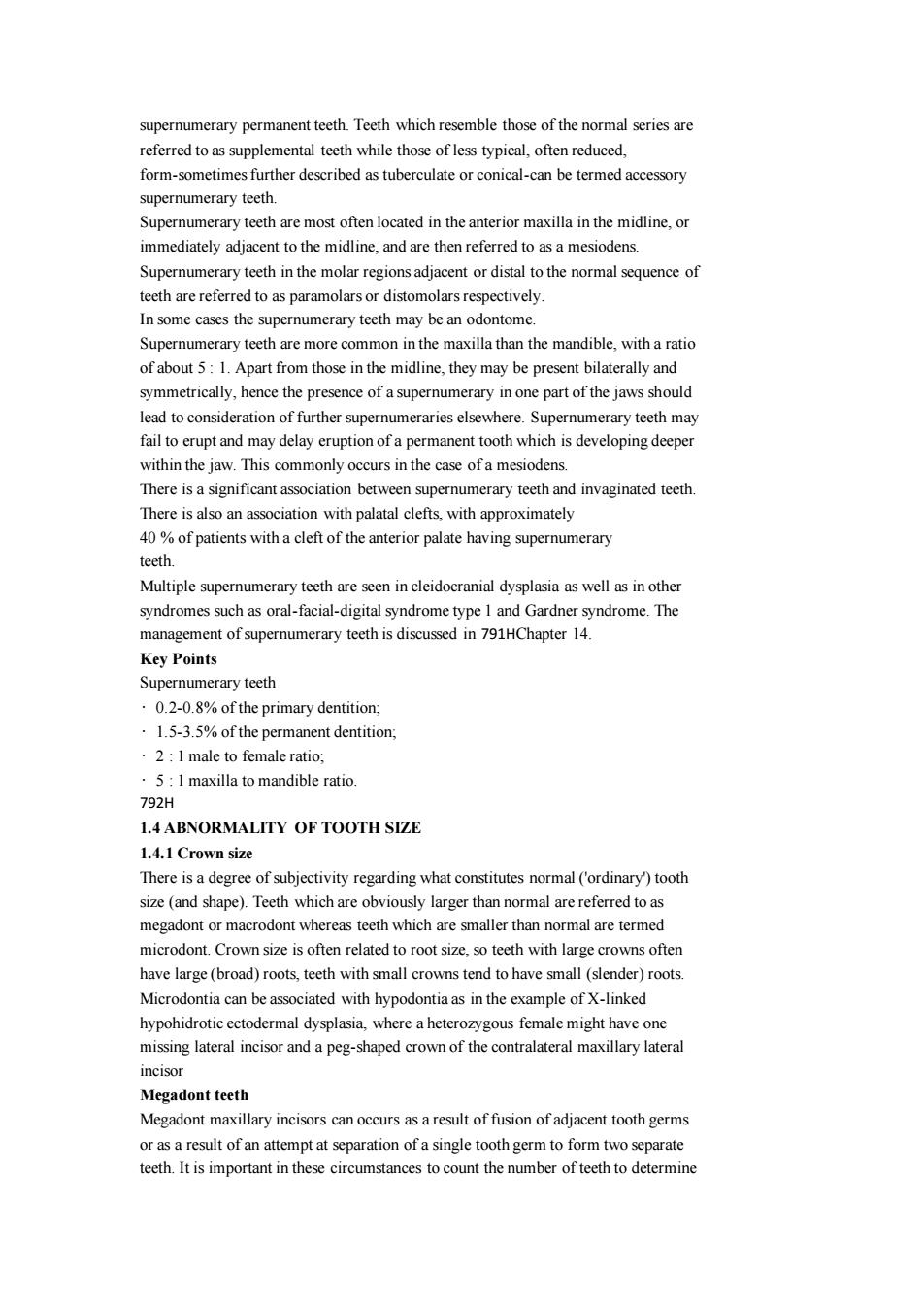
supernumerary permanent teeth.Teeth which resemble those of the normal series are supplemental teeth hile those of typical,ofen reduced supernumerary teeth Supernumerary teeth are most often located in the anterior maxilla in the midline.or immediately adjacent to the midline,and are then referred to as a mesiodens. molars respectively In some cases the supernumerary teeth may be an odontom Supernumerary teeth are more common in the maxilla than the mandible,with a ratio of about 5:1.Apart from those in the midline,they may be present bilaterally and symmetrically,hence the presence of a supernumerary in one part of the jaws should within the jaw.This commonly occurs in the case ofa mesiodens There is a significant association between supernumerary teeth and invaginated teeth There is also an association with palatal clefts.with approximately 40of patients with a the anterior palate having supernu merar Multiple supernumerary teeth are seen in cleidocranial dysplasia as well as in other syndromes such as oral-facial-digital syndrome type 1 and Gardner syndrome.The management of supernumerary teeth is discussed in 791HChapter 14. Key Points 1.5-3.5%of the permanent dentition. 2:I male to female ratio: 5:1 maxilla to mandible ratio 702H 1.4 ABNORMALITY OF TOOTH SIZE 1.4.1 Crown size There is a degree of subiectivity regarding what constitutes normal (ordinary")tooth size (and shape).Teeth which are obviously larger than normal are referred to as megadont or macrodont whereas teeth which are smaller than normal are termed microdont Crown size is ofe related large often have large(broad)roots,teeth with small crowns tend to have small(slender)roots Microdontia can be associated with hypodontia as in the example of X-linked hypohidrotic ectodermal dysplasia,where a heterozygous female might have one missing lateral incisor and a peg-shaped crown of the contralateral maxillary lateral Megadont teeth Megadont maxillary incisors can occurs as a result of fusion of adjacent tooth germs or as a result of an attempt at separation of a single tooth germ to form two separate teeth.It is important in these circumstances to count the number of teeth to determine
supernumerary permanent teeth. Teeth which resemble those of the normal series are referred to as supplemental teeth while those of less typical, often reduced, form-sometimes further described as tuberculate or conical-can be termed accessory supernumerary teeth. Supernumerary teeth are most often located in the anterior maxilla in the midline, or immediately adjacent to the midline, and are then referred to as a mesiodens. Supernumerary teeth in the molar regions adjacent or distal to the normal sequence of teeth are referred to as paramolars or distomolars respectively. In some cases the supernumerary teeth may be an odontome. Supernumerary teeth are more common in the maxilla than the mandible, with a ratio of about 5 : 1. Apart from those in the midline, they may be present bilaterally and symmetrically, hence the presence of a supernumerary in one part of the jaws should lead to consideration of further supernumeraries elsewhere. Supernumerary teeth may fail to erupt and may delay eruption of a permanent tooth which is developing deeper within the jaw. This commonly occurs in the case of a mesiodens. There is a significant association between supernumerary teeth and invaginated teeth. There is also an association with palatal clefts, with approximately 40 % of patients with a cleft of the anterior palate having supernumerary teeth. Multiple supernumerary teeth are seen in cleidocranial dysplasia as well as in other syndromes such as oral-facial-digital syndrome type 1 and Gardner syndrome. The management of supernumerary teeth is discussed in 791HChapter 14. Key Points Supernumerary teeth • 0.2-0.8% of the primary dentition; • 1.5-3.5% of the permanent dentition; • 2 : 1 male to female ratio; • 5 : 1 maxilla to mandible ratio. 792H 1.4 ABNORMALITY OF TOOTH SIZE 1.4.1 Crown size There is a degree of subjectivity regarding what constitutes normal ('ordinary') tooth size (and shape). Teeth which are obviously larger than normal are referred to as megadont or macrodont whereas teeth which are smaller than normal are termed microdont. Crown size is often related to root size, so teeth with large crowns often have large (broad) roots, teeth with small crowns tend to have small (slender) roots. Microdontia can be associated with hypodontia as in the example of X-linked hypohidrotic ectodermal dysplasia, where a heterozygous female might have one missing lateral incisor and a peg-shaped crown of the contralateral maxillary lateral incisor Megadont teeth Megadont maxillary incisors can occurs as a result of fusion of adjacent tooth germs or as a result of an attempt at separation of a single tooth germ to form two separate teeth. It is important in these circumstances to count the number of teeth to determine
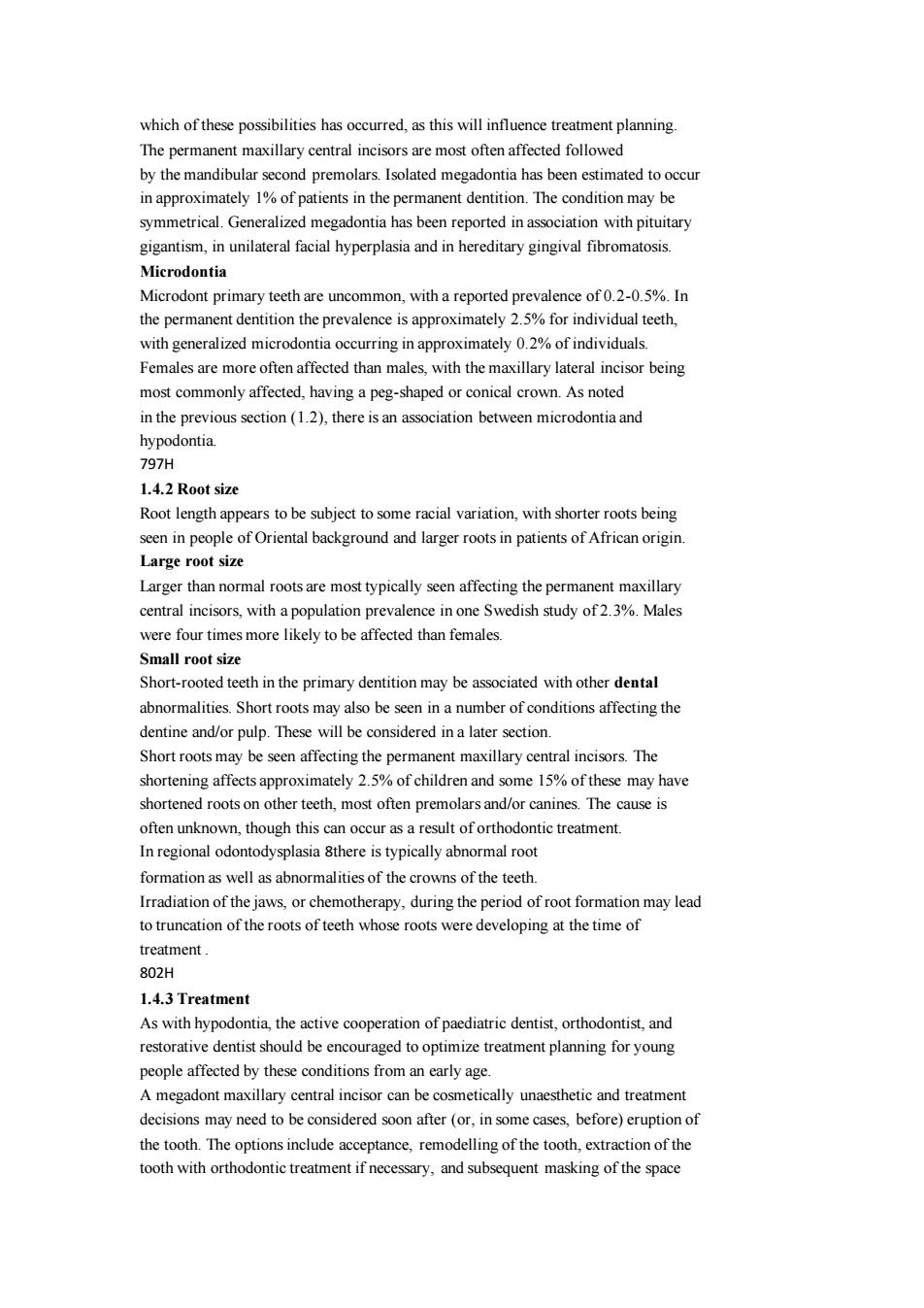
which of these possibilities has occurred,as this will influence treatment planning. by the mandibular second premolars.Isolated megadontia has been estimated tooccur in approximately 1%of patients in the permanent dentition.The condition may be symmetrical.Generalized megadontia has been reported in association with pituitary gigantism.in unilateral facial hyperplasia and in hereditary gingival fibromatosis Microdontia Microdont primary teeth are uncom with a reported prevalence f%In the permanent dentition the prevalence is approximately 2.5%for individual teeth, with generalized microdontia occurring in approximately 0.%of individuals. Females are more often affected than males.with the maxillary lateral incisor being most commonly affected,having a peg-shaped or conical crown.As noted hypodontia. 797H 1.4.2 Root size nghappabe c to som rcia vartion ckground and larger roots in patients of Afri can origi Large root re Larger than normal roots are most typically seen affecting the permanent maxillary central incisors,with a population prevalence in one Swedish study of 2.3%.Males were four times more likely to be affected than females. Small root size Short-oohinthe maybe abnormalities.Short roots may also be seen in a number of conditions affecting the dentine and/or pulp.These will be considered in a later section Short roots may be seen affecting the permanent maxillary central incisors.The shortening affects appr ximately 2 5%of children and so me 15%ofthese may have er teeth,most often premolar canines.The cause is often unkno wn.though this as a result of In regional odontodysplasia 8there is typically abnormal root formation as well as abnormalities of the crowns of the teeth. Irradiation of the jawsor chemotherapy.during the period of root formation may lead to truncation of the r oots of teeth who edeveloping t the e time of 14.3 Treatment As with hypodontia the active cooperation of paediatric dentist.orthodontist.and restorative dentist should be encou ged planning for youn people afected by A megadont maxillary central incisor can be cosmetically unaesthetic and treatment decisions may need to be considered soon after (or.in some cases.before)eruption of the tooth.The options include acceptance.remodelling of the tooth,extraction of the tooth with orthodontic treatment if necessary.and subsequent masking of the space
which of these possibilities has occurred, as this will influence treatment planning. The permanent maxillary central incisors are most often affected followed by the mandibular second premolars. Isolated megadontia has been estimated to occur in approximately 1% of patients in the permanent dentition. The condition may be symmetrical. Generalized megadontia has been reported in association with pituitary gigantism, in unilateral facial hyperplasia and in hereditary gingival fibromatosis. Microdontia Microdont primary teeth are uncommon, with a reported prevalence of 0.2-0.5%. In the permanent dentition the prevalence is approximately 2.5% for individual teeth, with generalized microdontia occurring in approximately 0.2% of individuals. Females are more often affected than males, with the maxillary lateral incisor being most commonly affected, having a peg-shaped or conical crown. As noted in the previous section (1.2), there is an association between microdontia and hypodontia. 797H 1.4.2 Root size Root length appears to be subject to some racial variation, with shorter roots being seen in people of Oriental background and larger roots in patients of African origin. Large root size Larger than normal roots are most typically seen affecting the permanent maxillary central incisors, with a population prevalence in one Swedish study of 2.3%. Males were four times more likely to be affected than females. Small root size Short-rooted teeth in the primary dentition may be associated with other dental abnormalities. Short roots may also be seen in a number of conditions affecting the dentine and/or pulp. These will be considered in a later section. Short roots may be seen affecting the permanent maxillary central incisors. The shortening affects approximately 2.5% of children and some 15% of these may have shortened roots on other teeth, most often premolars and/or canines. The cause is often unknown, though this can occur as a result of orthodontic treatment. In regional odontodysplasia 8there is typically abnormal root formation as well as abnormalities of the crowns of the teeth. Irradiation of the jaws, or chemotherapy, during the period of root formation may lead to truncation of the roots of teeth whose roots were developing at the time of treatment . 802H 1.4.3 Treatment As with hypodontia, the active cooperation of paediatric dentist, orthodontist, and restorative dentist should be encouraged to optimize treatment planning for young people affected by these conditions from an early age. A megadont maxillary central incisor can be cosmetically unaesthetic and treatment decisions may need to be considered soon after (or, in some cases, before) eruption of the tooth. The options include acceptance, remodelling of the tooth, extraction of the tooth with orthodontic treatment if necessary, and subsequent masking of the space